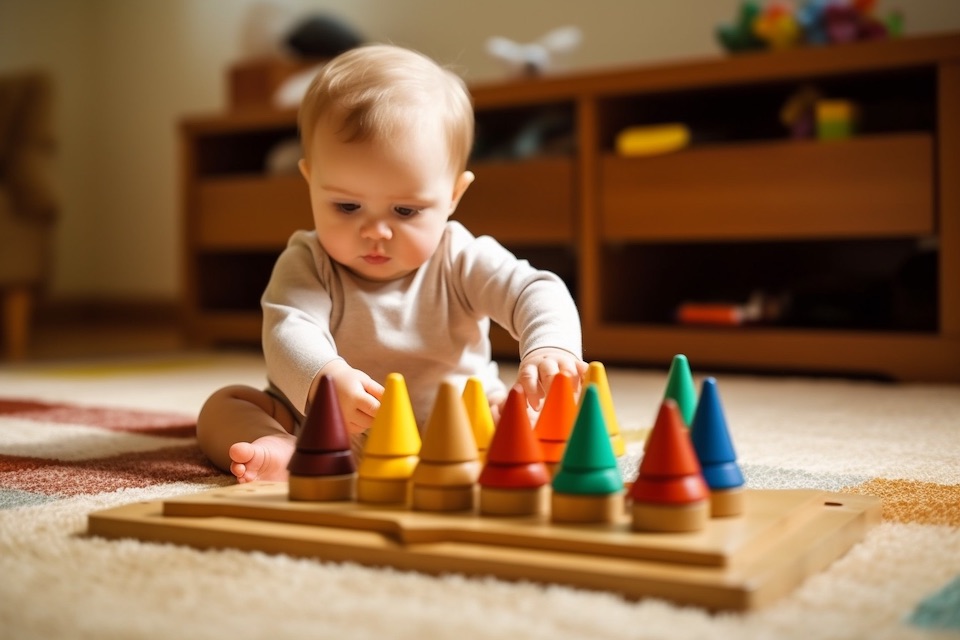Montessori Activities for the Development of your baby

Maria Montessori, a pioneering Italian physician and educator, strongly believed in fostering independence and respect for a child’s natural psychological and intellectual development. For over a century, the Montessori approach to child-rearing and education has empowered children, guiding them through their unique journey of growth and development. That’s where Montessori Activities come in to support your Baby’s development.
The Purpose of Montessori Activities for Babies
The primary goal of Montessori activities isn’t to enhance the intellect or hasten the milestone achievements of our babies. Instead, these activities aim to acknowledge the individuality of our babies, support their developmental needs, and facilitate their progression from dependence to collaboration and, eventually, to independence.
In the earliest stages, the primary areas of development that Montessori activities target are movement and language. These activities offer a stimulating environment for intellectual and psychological development. Here, babies learn to make connections, comprehend language, challenge their physical capabilities, and gain confidence and trust in their surroundings.
Choosing Montessori Activities: A Guided Approach
The process of selecting Montessori activities for our infants involves understanding their current developmental stage, observing their interests and progress, and then offering supportive resources. Here are a few considerations:
- Materials: Opt for natural materials like wood, fabric, rubber, and stainless steel that are safe for mouthing.
- Size: Ensure that the baby can manipulate the object and that all components are secure and pose no choking risk.
- Beauty: Beautiful and aesthetically pleasing materials stimulate the baby’s absorbent mind.
- Variation: Introduce an array of activities with different colors, sizes, weights, textures, shapes, and functions. This variety can enhance understanding of properties and functions.
Montessori activities are inherently intuitive. We don’t need to instruct our babies—instead, we prepare the play environment and provide toys and materials at the right time.
Timing and Context: When to Offer Montessori Activities
Offer activities when your baby is alert, content, and comfortable. Their interaction with materials may not always be evident. Their activity could be calm and subtle. As long as they are content, there’s no need to intervene.
Remember, it’s essential not to impose your feelings or expectations on the baby’s playtime. Refrain from placing toys in the baby’s hands or shaking toys to attract their attention. Instead, place an item within view and reach and let them choose to engage. This practice fosters independence and encourages intentional and purposeful actions.
Our Role: Preparing the Environment, Not Entertaining
The foundation for independent play is laid during the baby’s first year. The parent or educator’s role is to understand the baby’s development, prepare the environment, link the baby to the environment, and allow freedom and time for exploration. It’s essential not to interfere or entertain; let the baby be the primary actor in their play.
Quality Over Quantity and Maintaining Order
Choose a few quality materials that will last, rather than numerous, less durable options. When it comes to activities, less is more. Limiting the number of activities prevents overwhelm and encourages concentration.
Additionally, it’s crucial to maintain and restore order in the environment. For babies, this task falls on us as the adults. However, once they become toddlers, they can begin to collaborate in restoring order, further fostering independence and responsibility.
List of Montessori Activities
Language Activities
Language development is at the heart of Montessori learning. The goal of Montessori language activities is not just to improve a child’s ability to communicate but to foster a love for language and expression.
Movement Activities
Physical movement is integral to the Montessori approach. These activities enhance motor skills, hand-eye coordination, balance, and physical health.
Music Activities
Music plays a crucial role in the Montessori curriculum, promoting cognitive development, emotional expression, and social skills.
Outdoor Activities
The outdoors provides a myriad of learning opportunities in the Montessori method. It promotes a connection with nature, sensory learning, physical development, and scientific understanding.
Montessori Activities for the Development of your baby
Montessori activities support a baby’s unique developmental path, fostering their individuality and independence from infancy. As parents and educators, our role isn’t to entertain or accelerate their growth, but to provide a conducive environment for exploration, discovery, and learning. By allowing them to be the main actors in their play, we build a foundation for their development.
Adam L
As a devoted father and experienced writer, I've discovered my passion for parenting. Being a dad myself, I know firsthand the joys and struggles of raising children and I want to share my experiences and insights with other parents. With my degree in journalism and years of experience as a writer, I've developed my unique writing style that combines humor with practical advice. I strive to provide a fresh and engaging perspective in my writing, giving my readers a glimpse into the joys and challenges of parenthood. Whether I'm writing about the early stages of parenting or the teenage years, I aim to make my content informative, entertaining, and relatable. I am committed to supporting and encouraging other parents on their parenting journey, and my writing reflects this dedication.
